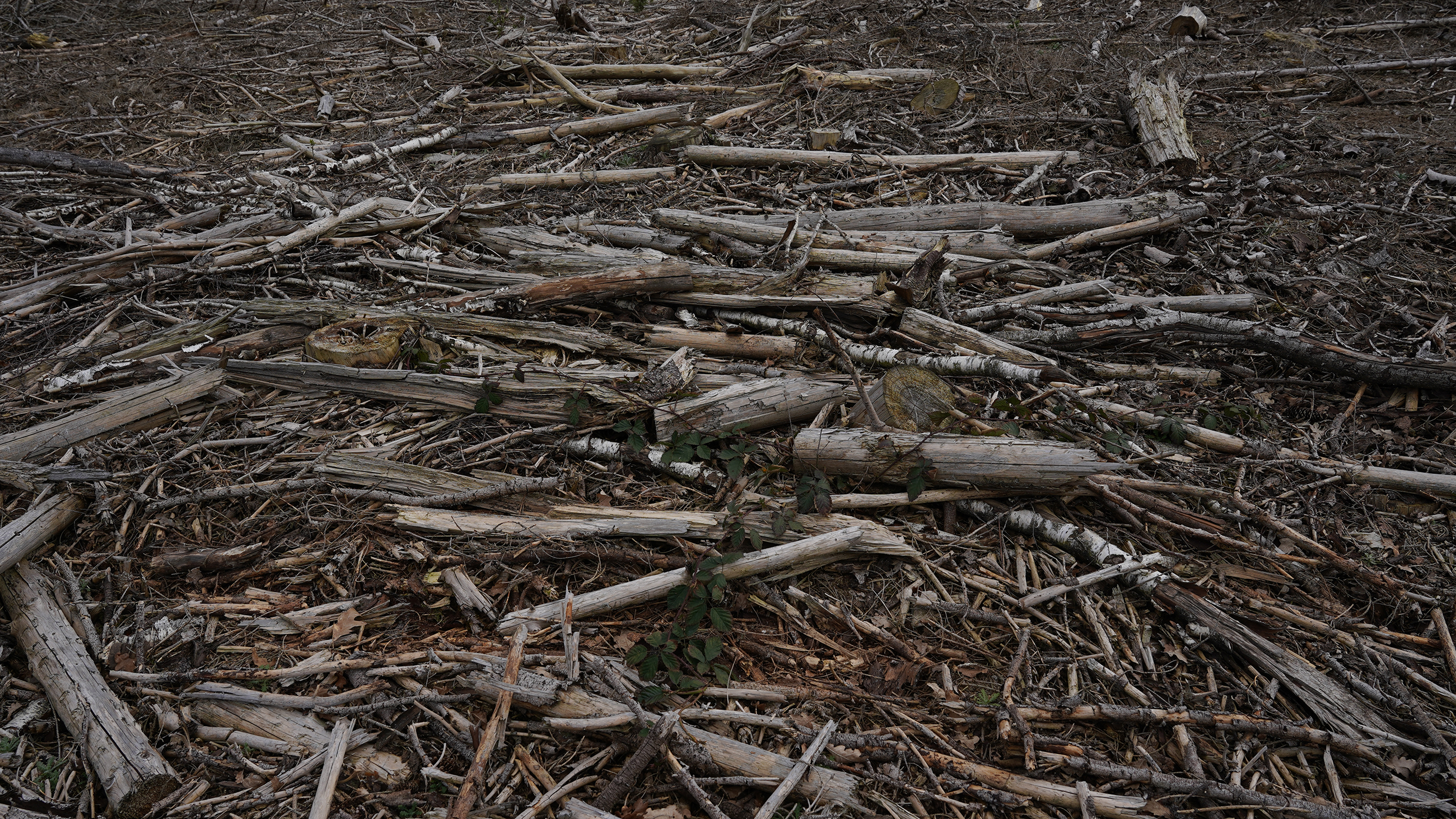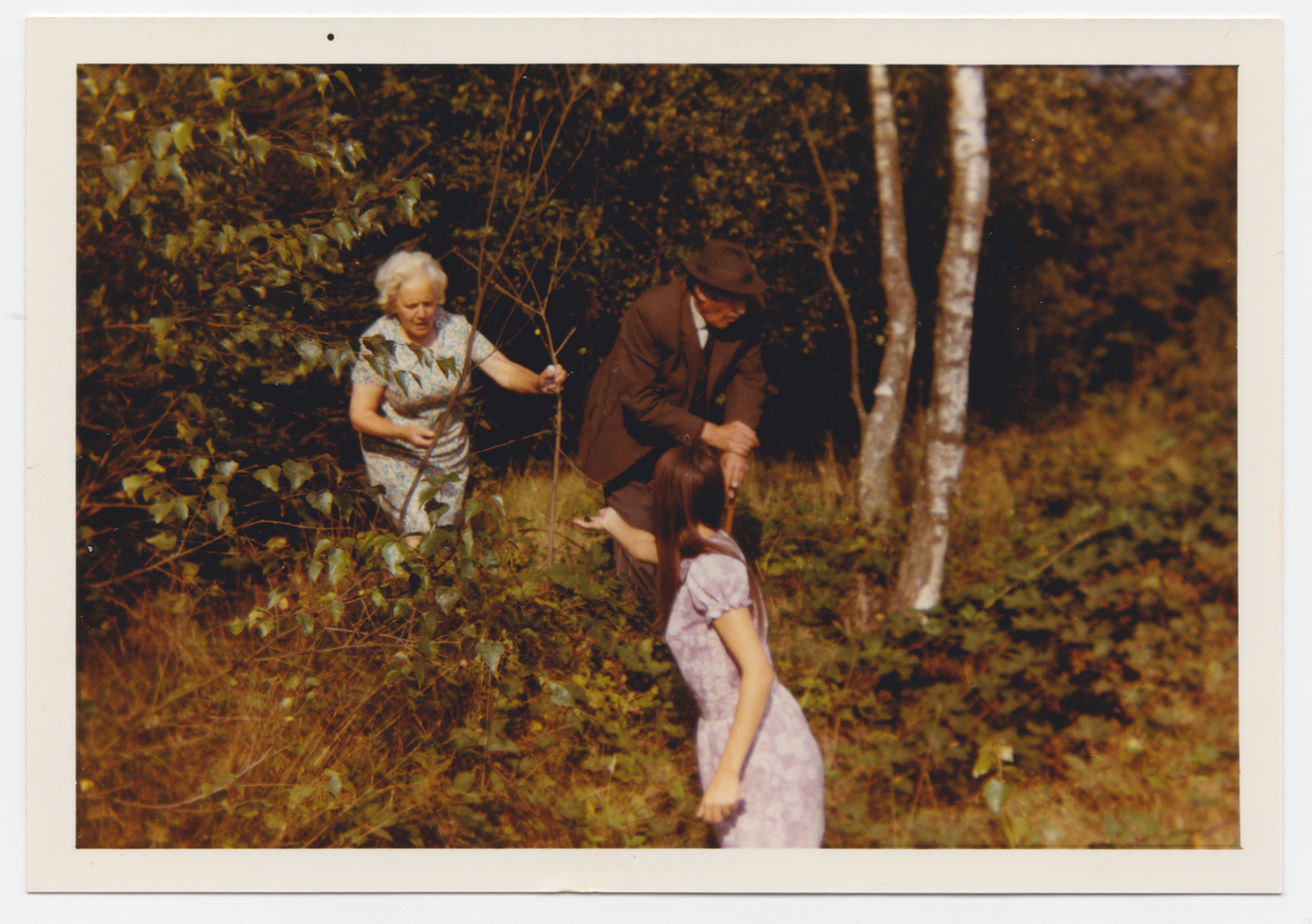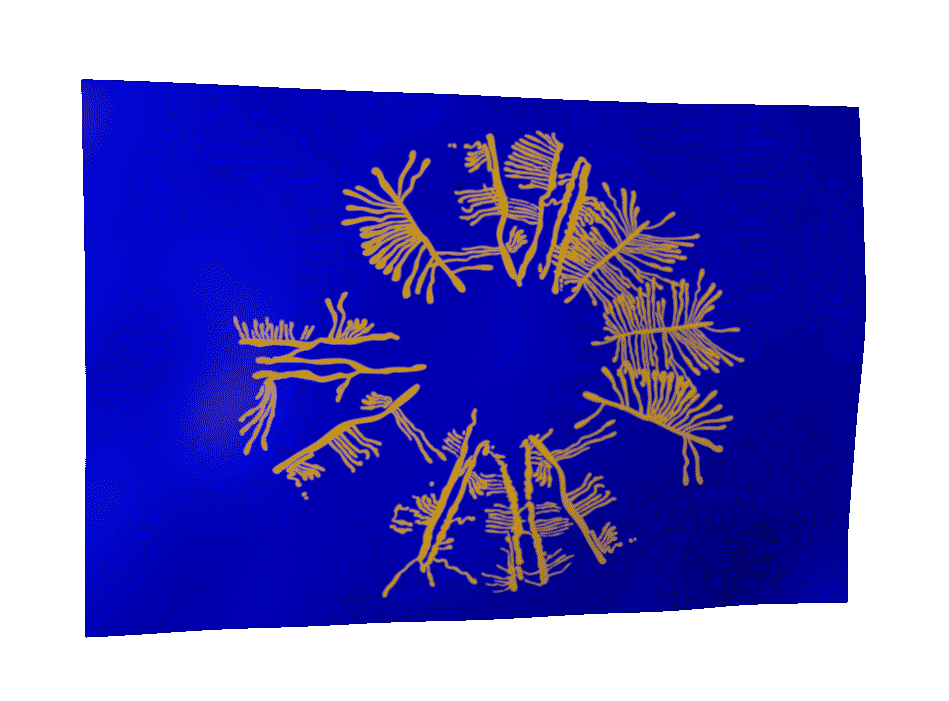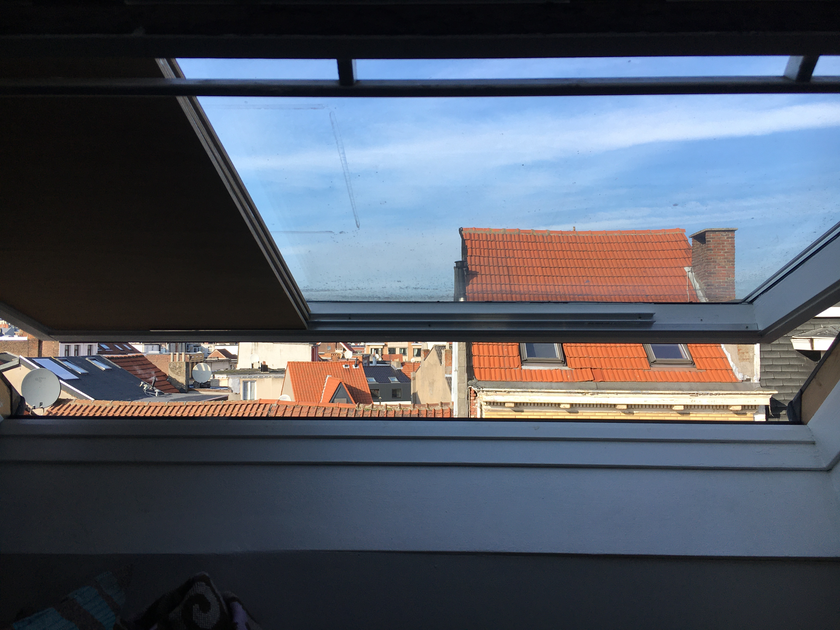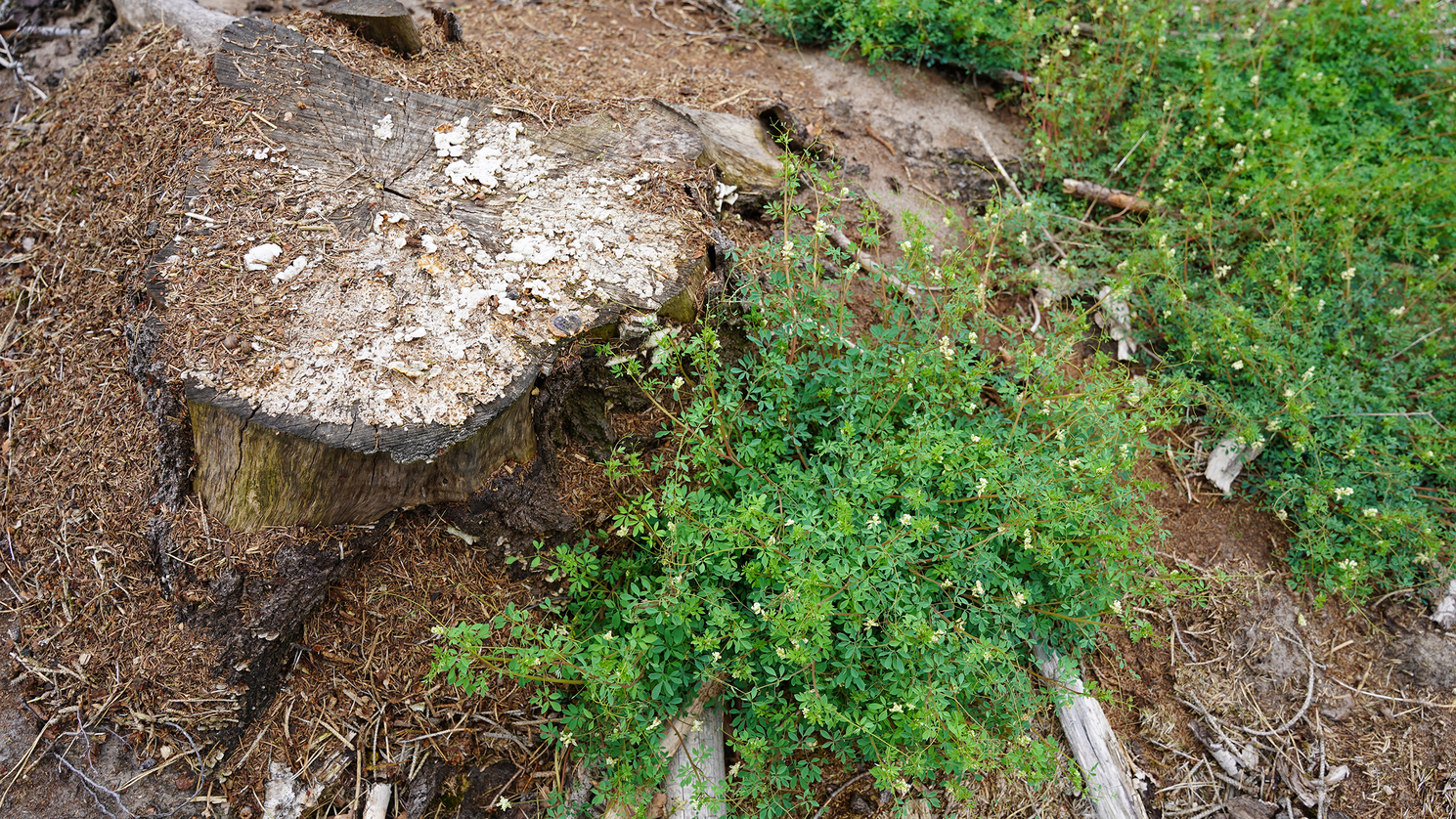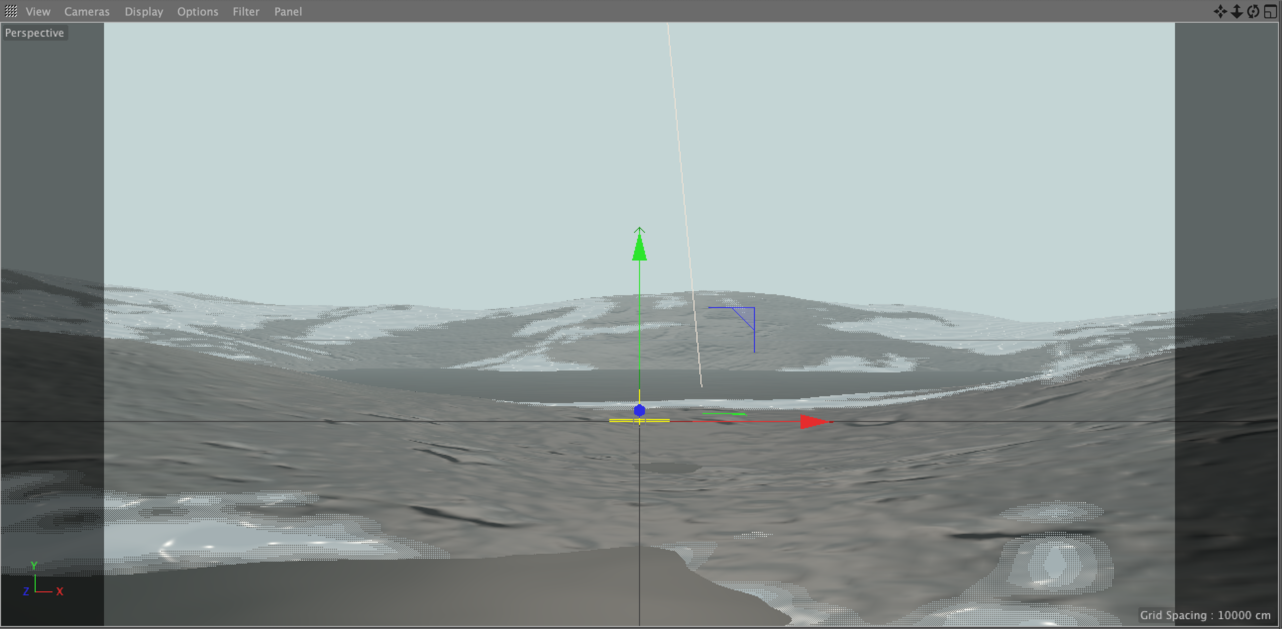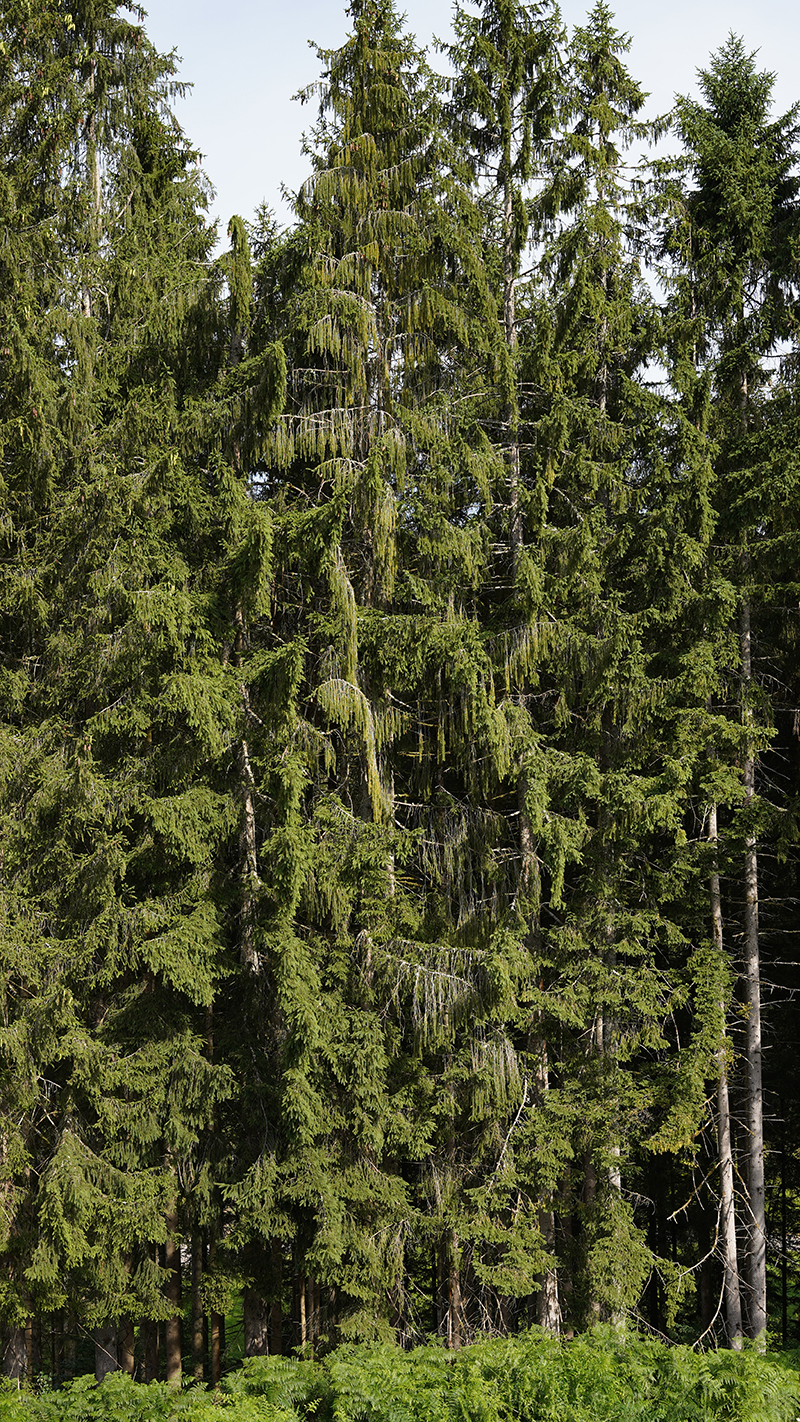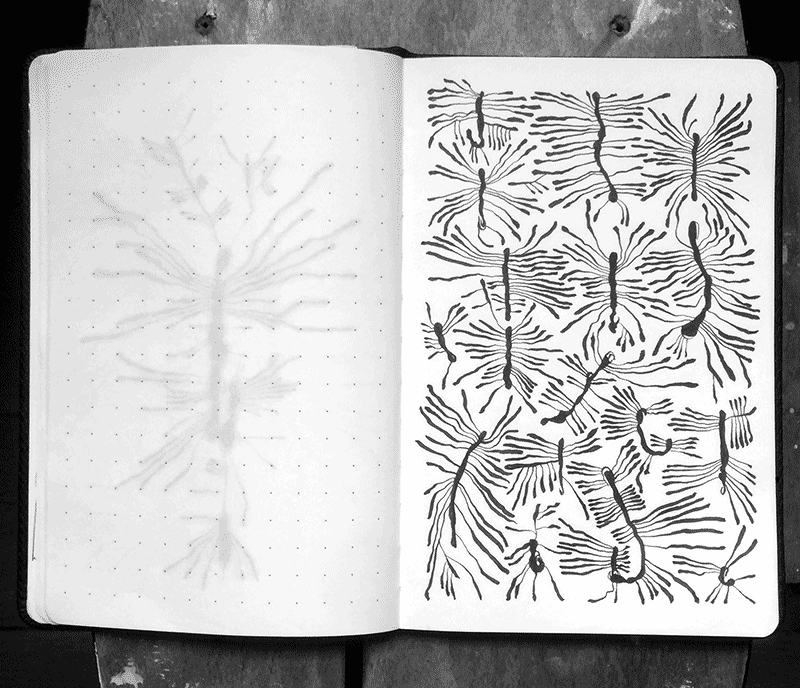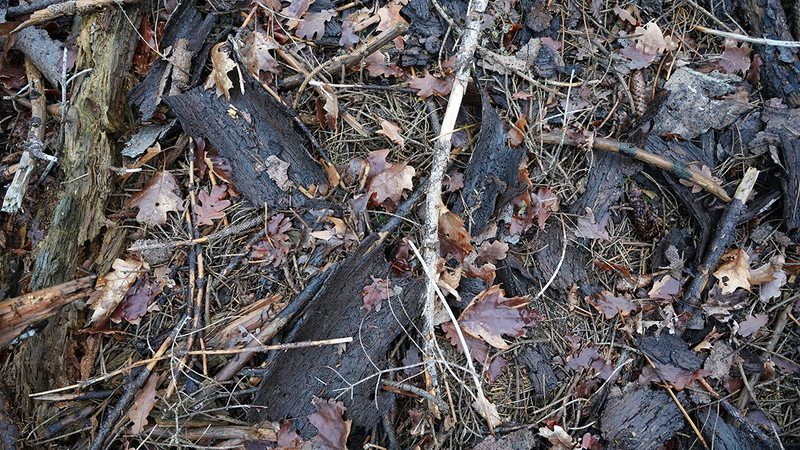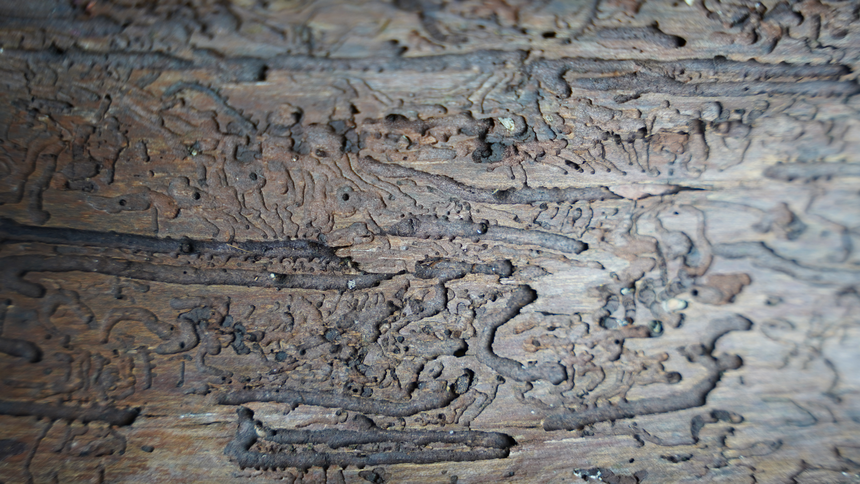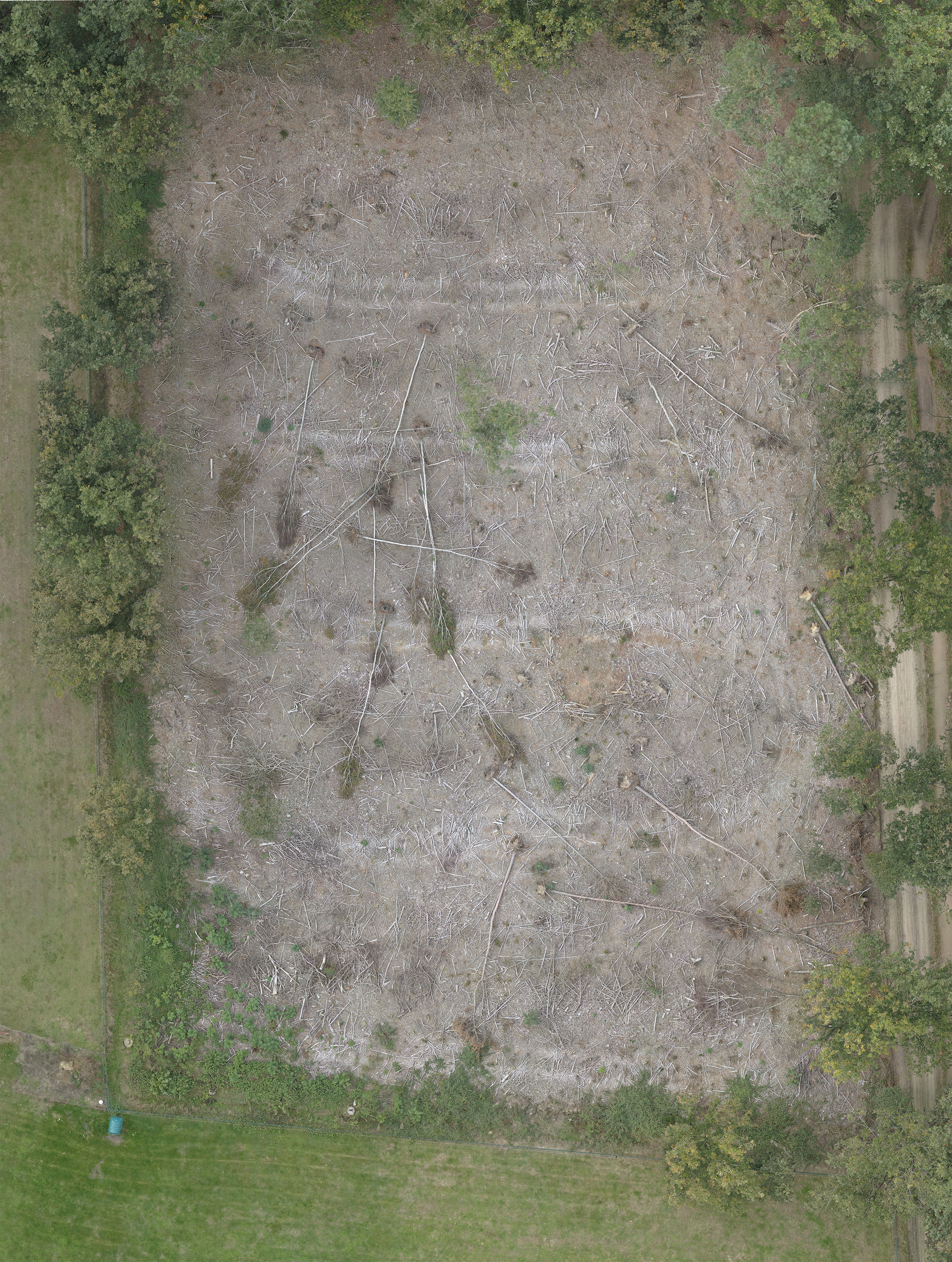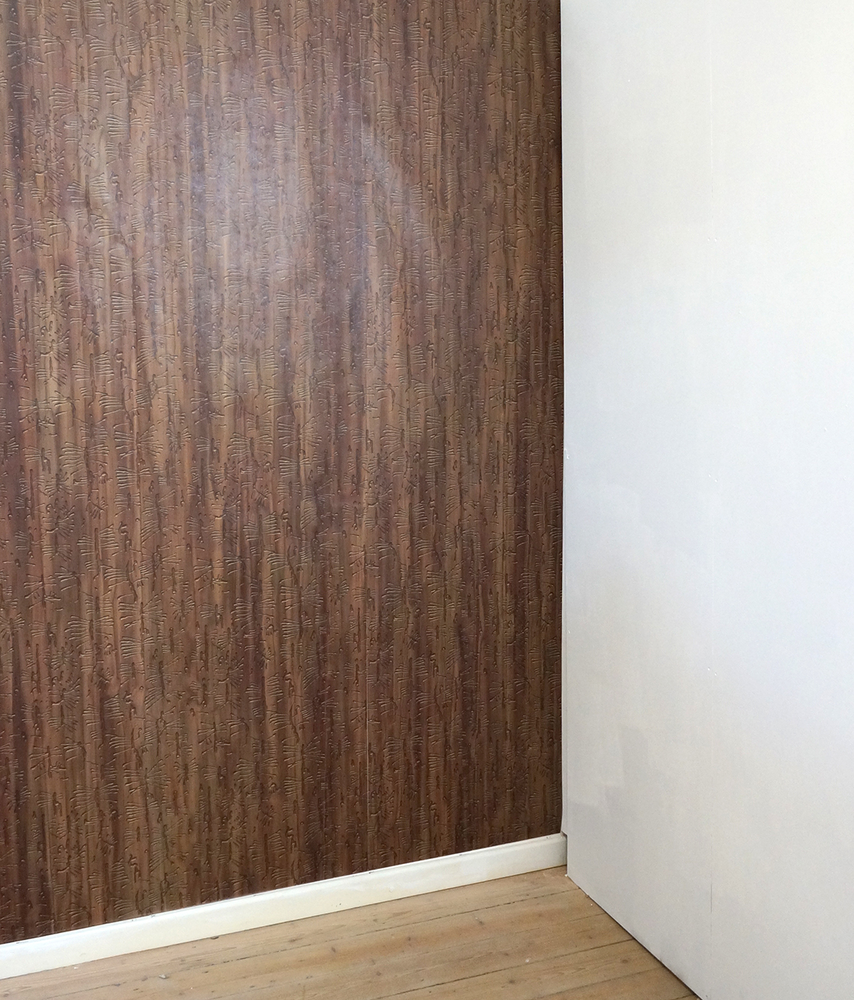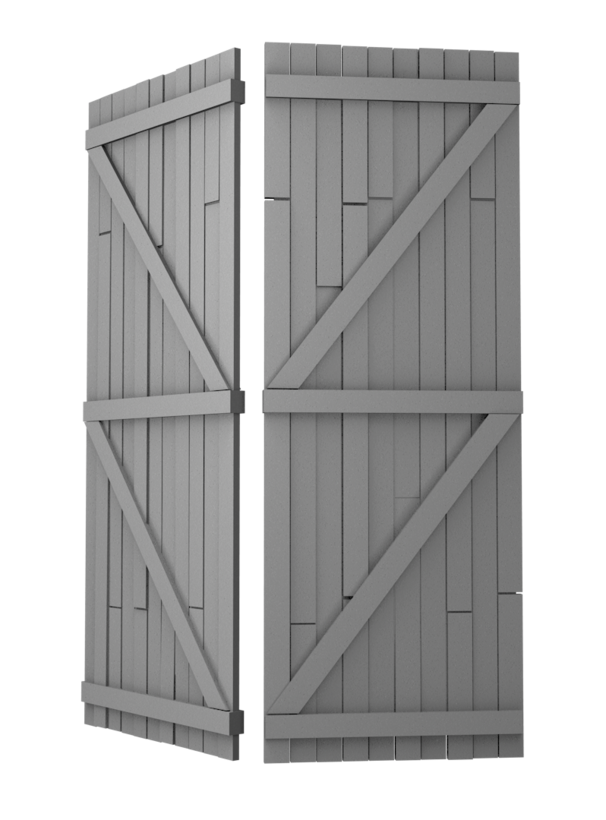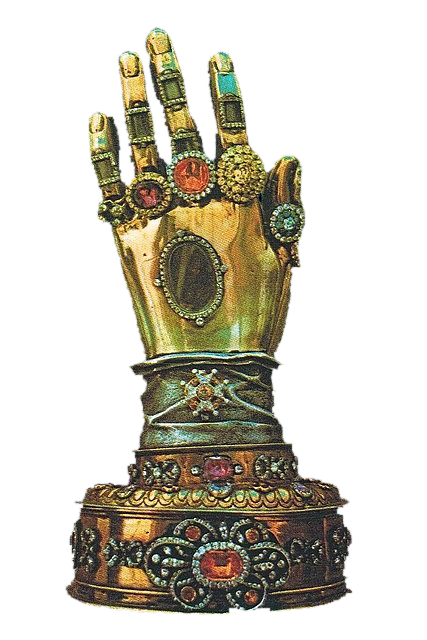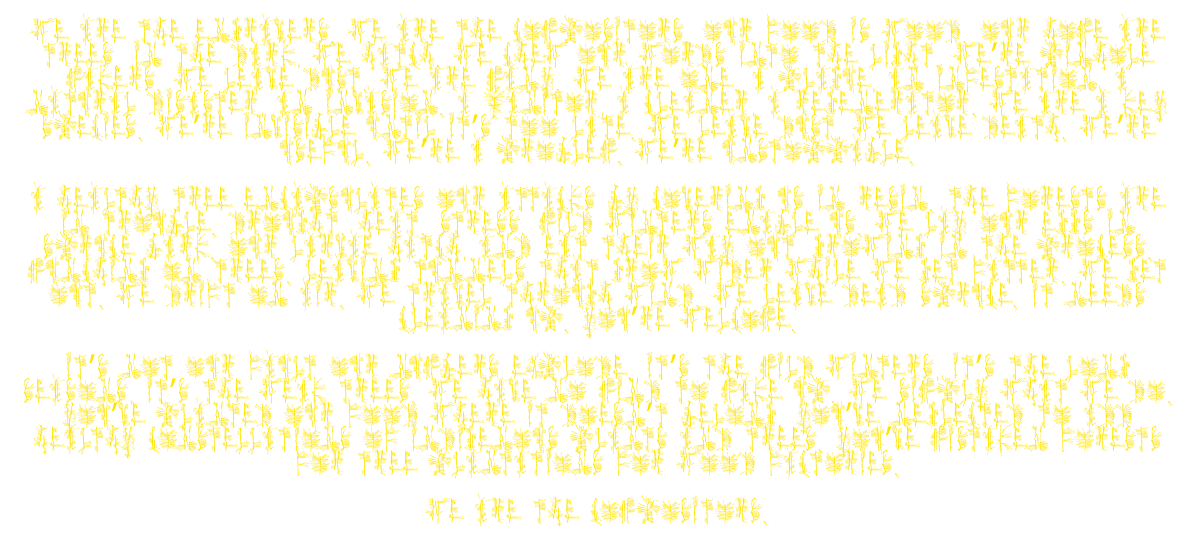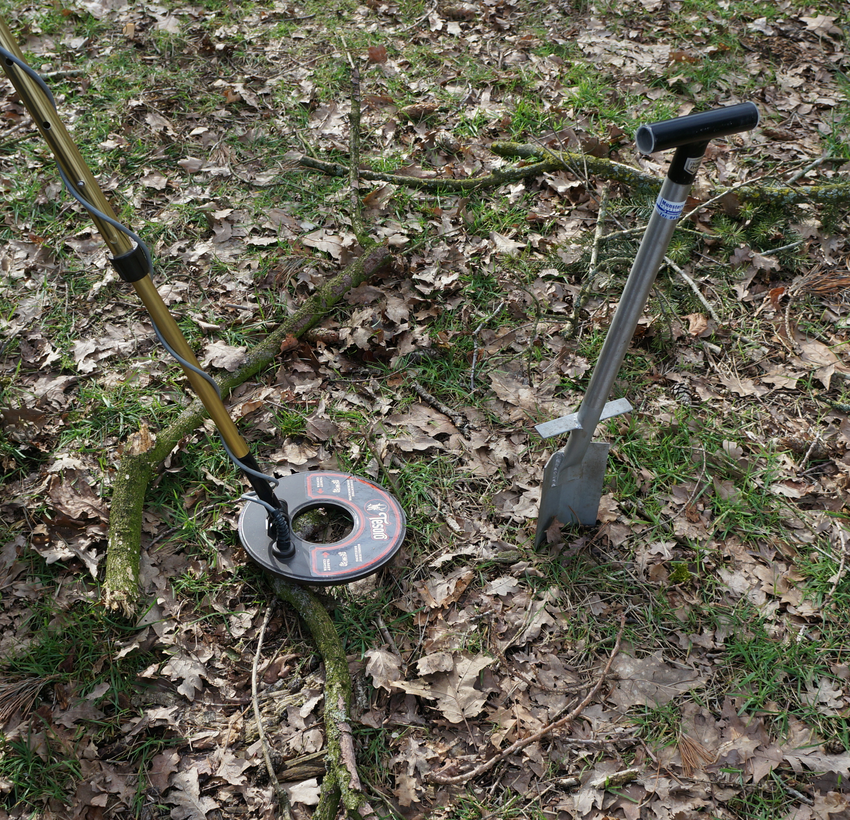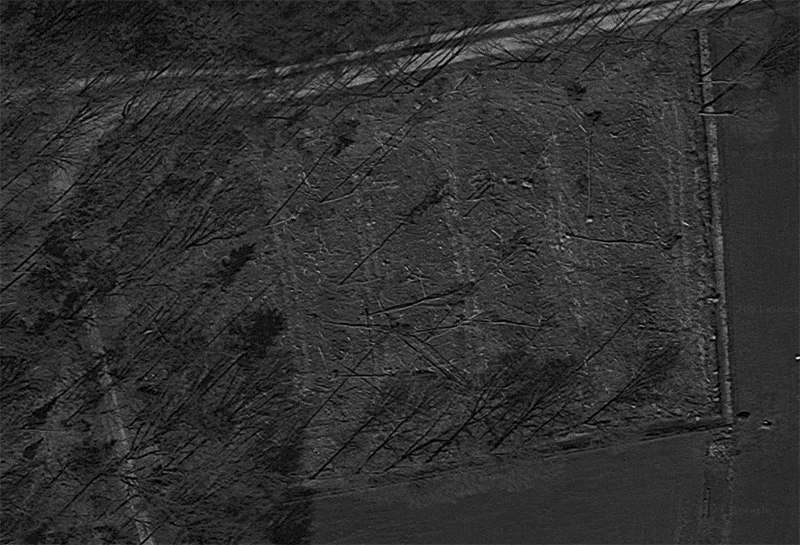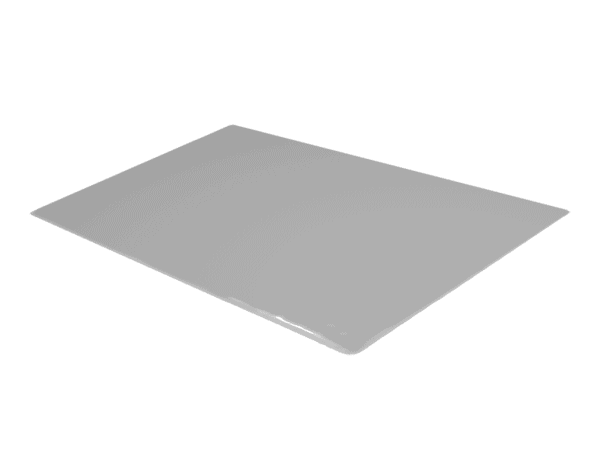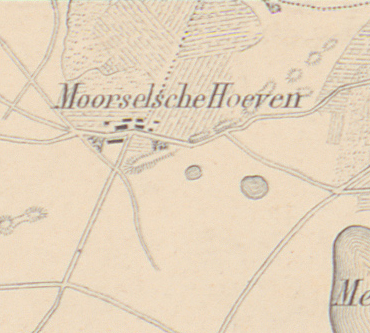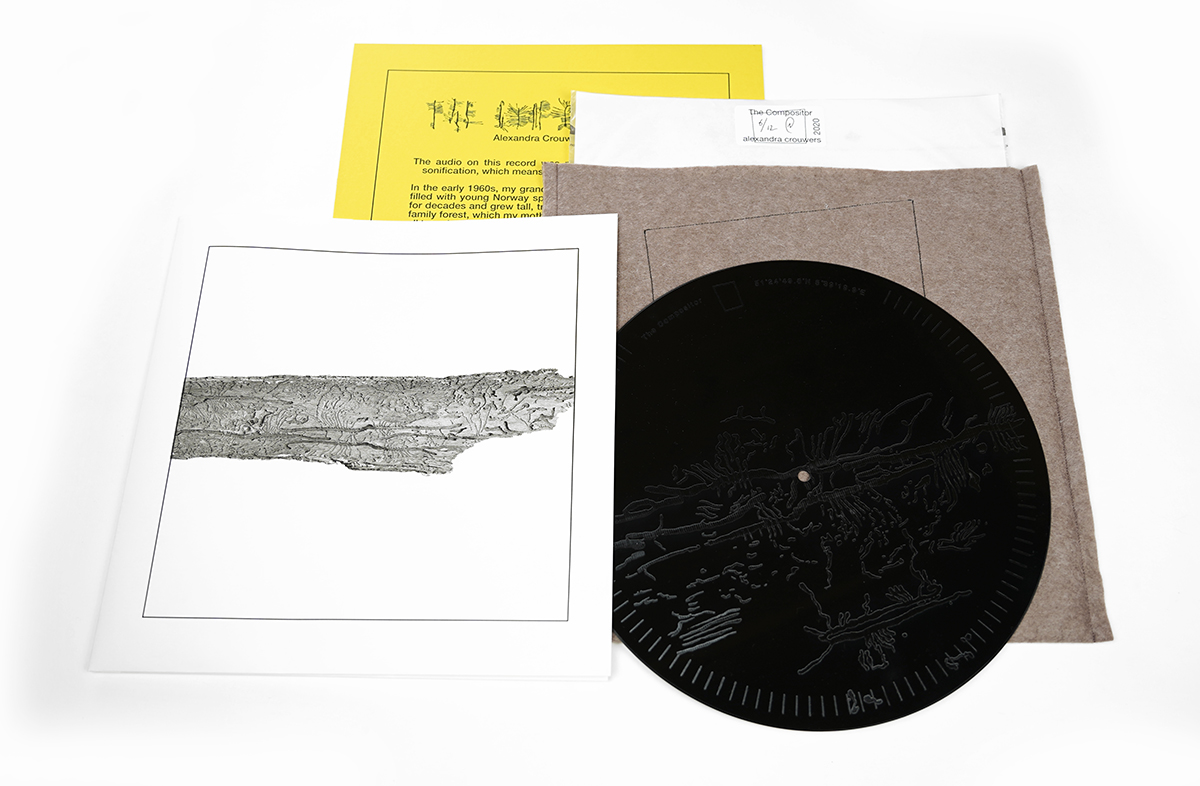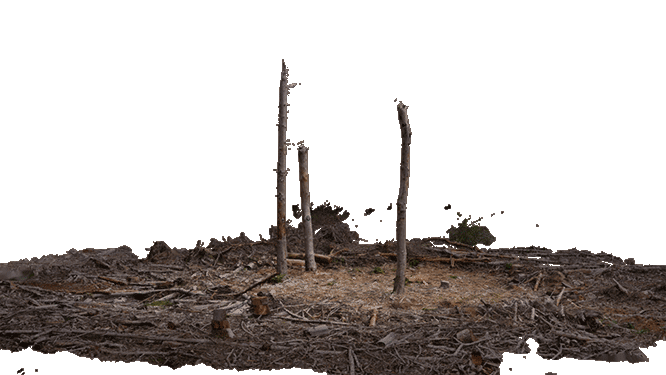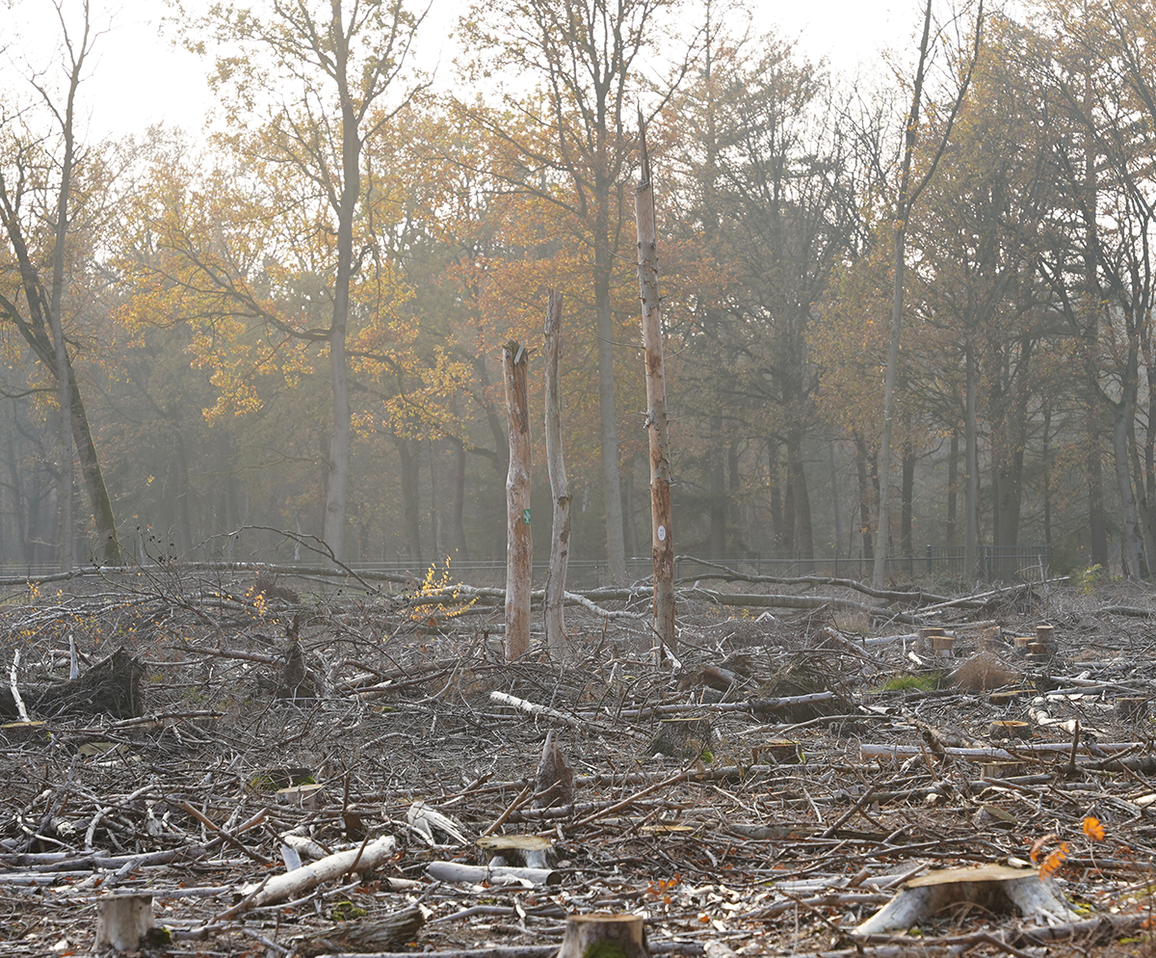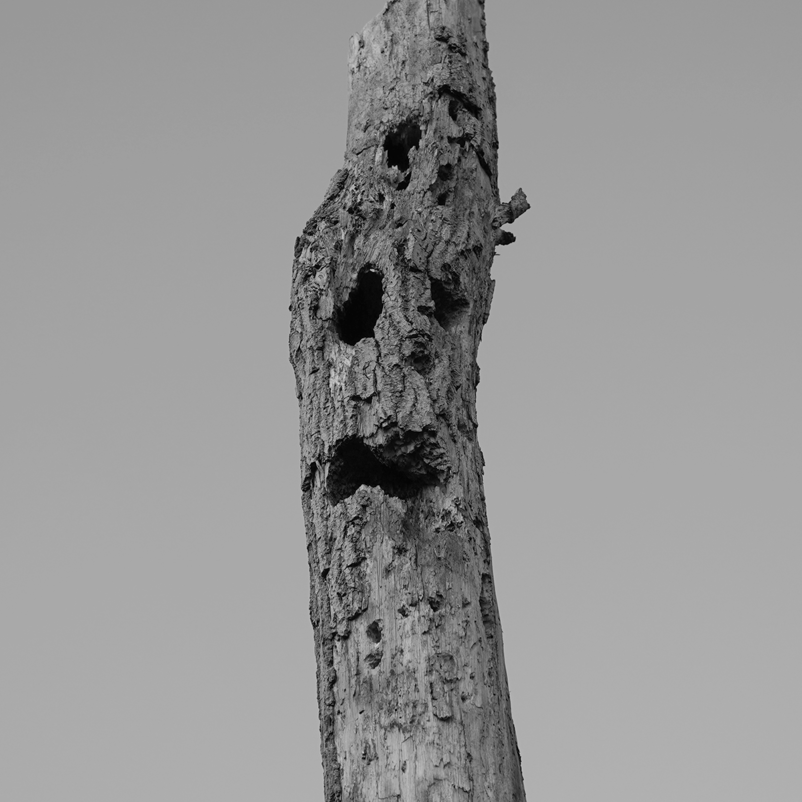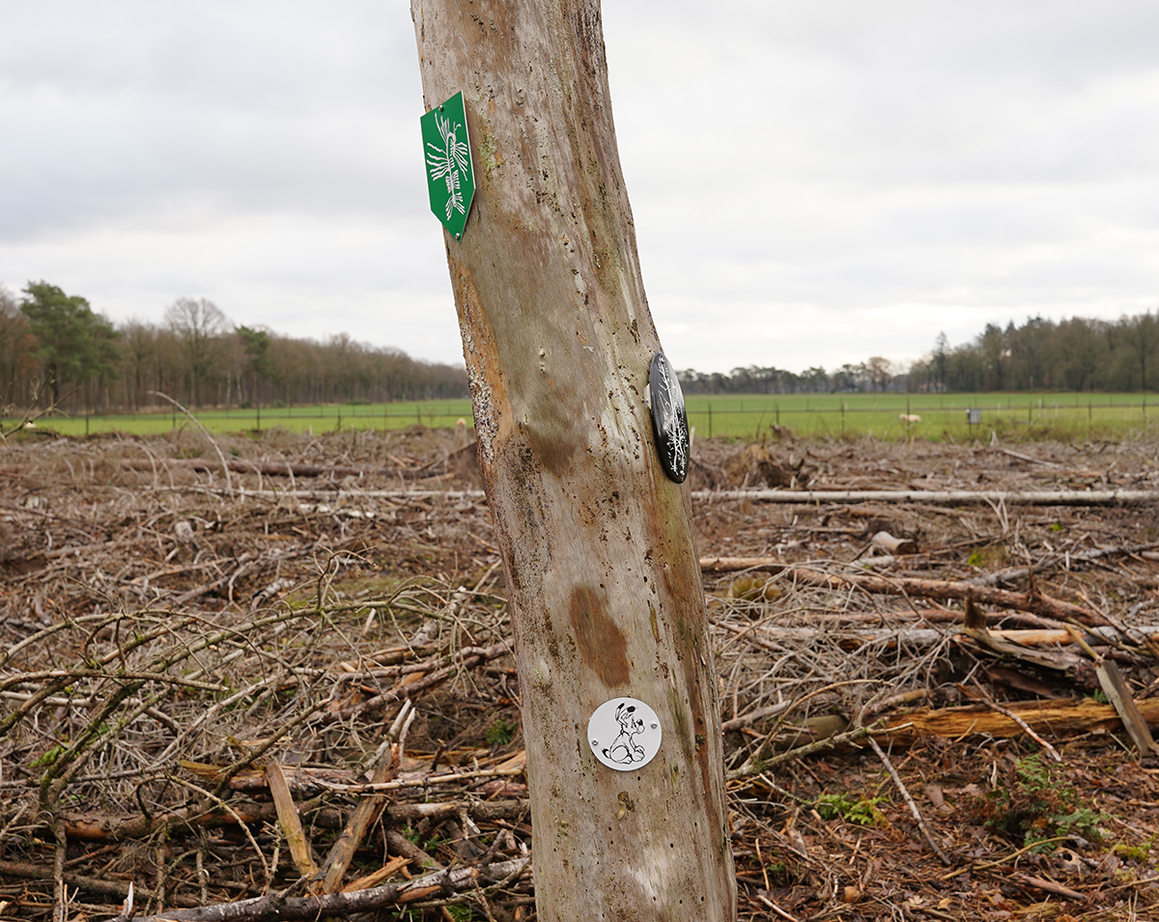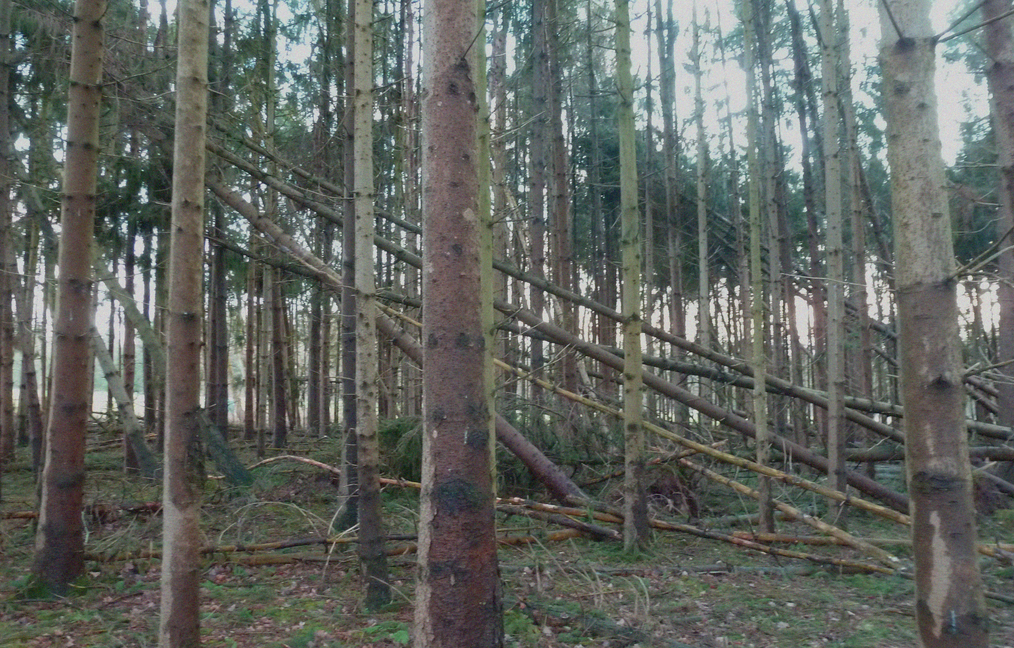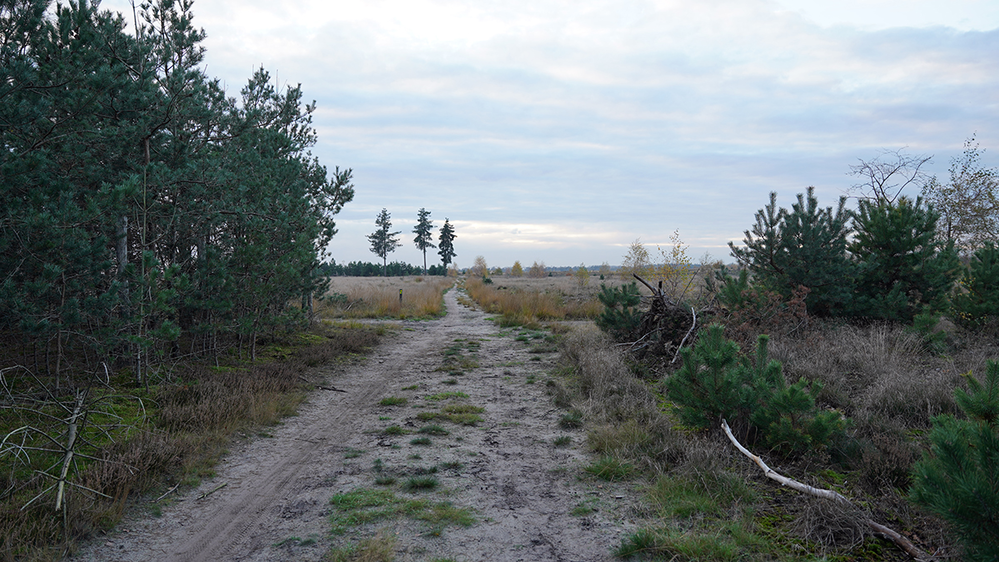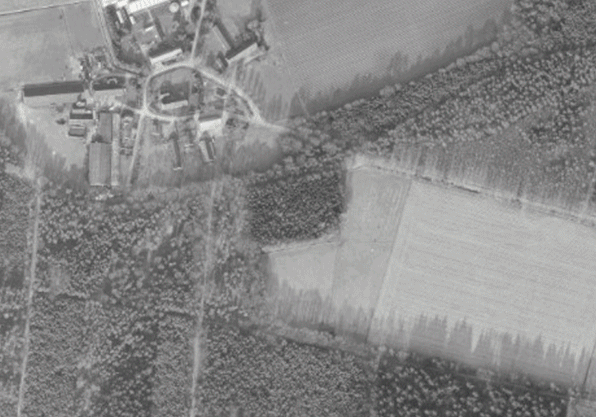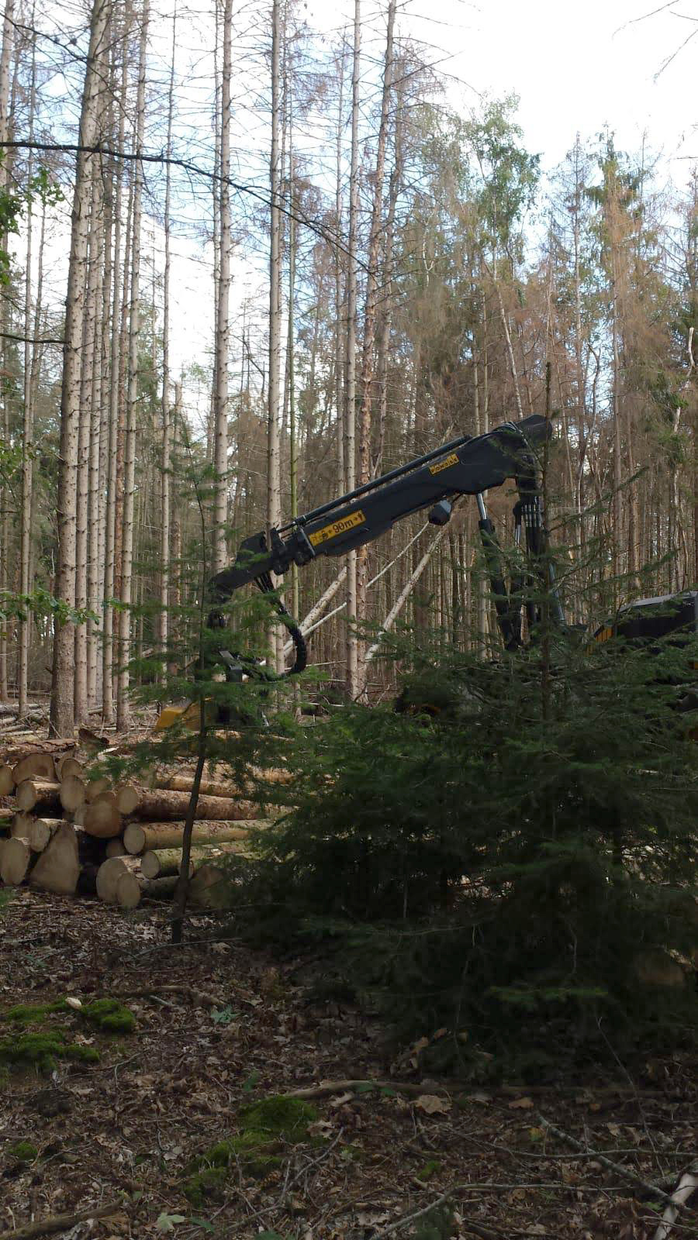Reading list
- Finding the Mother Tree, Suzanne Simard, Allen Lane, 2021
- Spillover. Animal Infections and the Next Human Pandemic, David Quammen, W.W. Norton & Company, 2012
- Earth Emotions. New Words for a New World, Glenn A. Aalbrecht, Cornell University Press, 2019
- The Hot Zone, Richard Preston, Anchor, 1994
- Duivelskwartier. 1595: heksen, heren en de dood in het vuur, Johan Otten, Vantilt, 2015
- The Garden of the Forking Paths (El jardín de senderos que se bifurcan), Jorge Luis Borges, Editorial Sur, 1941, translated in English in 1948
- Kraken, China Miéville, Macmillan, 2010
For over 15 years, an important part of my artistic practice arises in the digital realm: in the infinite void right behind the glass of my computer screen, where I'm navigating between the virtual x, y, and z axes of 3D software.
In this immaterial environment, I've imagined Distant Pasts and Far Futures in which my concern for the ecological state of this planet lingered. Until recently, I would say that escapism is my core business.
In my urban studio, my view on the city's rooftops would be replaced with wide landscapes, simulated nature inhabited by artificial trees. The densely populated area outside, with its impossibly complicated social relations, is exchanged for uninhabited worlds. Here, humanity would be reduced to remnants.
Between 2019 and 2023 I'm working on a doctoral artistic research project, The Appeal of the Unreal, that began as an investigation of simulated nature through screen culture and habitat dioramas. But already within months of the start of this route, something happened that awoke a sense of urgency, pulling the project out of the comfort of the virtual axes and dropping it in Real Life coordinates.
In my artistic output, non-linearity is an unlikely constant. Actions can take place simultaneously, in another sphere, or in random order. There's something of a timeline when it comes to the geological record of The Plot, but the path of chronology is more or less abandoned in this virtual record.
All you need to know is this: in the early 1960s, my grandfather bought a small forest near the village where he was born. Being from a Catholic farmer's family in the south of the Netherlands, my grandparents produced an impressive number of family members, all of them with a relation to het bosje (the little forest), as we would call it. In my childhood, we would have pic nics there, and later on, we would regularly visit the little forest to see how it was evolving. After my grandparents died, my mother inherited it. She's the current owner, and my partner in crime.
In September 2019, the little forest had to be cleared, and it transformed into The Plot. The Plot has become an arena for artistic research, functioning as a lens to investigate greater ecological issues. It now embodies ecological grief.
In 2020, the global upheaval of a virus added multiple dimensions to The Plot. We need to find ways to deal with issues that are beyond a human scale, and that resonate beyond our lifetime.
At the moment, The Plot is slowly being prepared for regeneration: a road that leads far beyond the horizon of my lifetime. There are many questions as to where to begin, what to set as targets, and how to proceed. A special role lies in building a mythology around The Plot. This proves to come easy: despite its relatively poor geological composition, The Plot is a quite fertile land for the imagination.
Some of the works you're presented with in this exposition have multiple aims, but they all arise from a desperate need to somehow help fix things. In that process, mistakes are made. I consider these mistakes to be of artistic value. In some cases, I'm even deliberately involved in scientific quackery, which I find an equally artistic medium.
This presentation shows part of the results of the first one-and-a-half year of my PhD trajectory.
An excerpt from 971220-980320, my graduation paper from the academy of art, Den Bosch (NL), illustrates some form of ecological grief already present in 1998.
"1997 was the hottest year since records began in 1782. In December, my mother’s chickens had chicks. One had eleven. Two were eaten by the cat. The other one had eight.
Early January trees started budding. A few days, temperatures reached 13, 14 degrees Celsius.
“Hooray! Spring is coming!”, people would say, “It’s so nice out.”
"Yeah, right," I thought, "Can't you see something is going horribly wrong?"
971220-980320, Alexandra Crouwers, Akademie voor Kunst en Vormgeving, 's-Hertogenbosch (NL), 1998, ISBN 90-71015-17-3
I'm certainly not a therapist, nor do I have the ambition to become one. The Plot is, in a way, becoming myth by centering a narrative that hovers between facts (the reality of ecological collapse, the actual presence of the land) and fiction (proposed 'solutions', the attempted (re)activation of land, and the name – The Plot – referencing scenarios). It's only suitable to delve into methods from other 'mythical' systems, whether that may be pop culture or practices such as the art of spagyria. This involves the use of special effects and (visual) trickery. This may be considered as an integral part of the poetic world of artistic research – as opposed to hard science – but evil tongues could define it as quackery.
The word quack comes from the Dutch word kwakzalver – which was spelled quacksalver in old spelling – 'hawker of salve'. In the Middle Ages, quack meant 'shouting', because merchants of dubious medical products would call out their supposed wholesomeness to the visitors of markets.
Despite its negative connotation, 'quackery' provides the elastic that is needed to stretch my artistic practise beyond the factualities of science. And in my quest for solutions to dealing with ecological grief I may encounter not only false ones; I may stumble upon functional ones, too.
There's also a sardonic pleasure in accumulating talismans, potions, or thought experiments. Some would call them mistakes.
Some parts in this chapter are taken from Mistakes. The artist talk. A 20 minutes and 20 seconds Powerpoint on steroids, made in April 2020, after my hasty return from a residency in New York, when Covid-19 hit the city.
Below: a rudimentary circle indicating an ants nest about 15 meters west to The Three Trees. Right: a red ant's nest. May 2021.
"We come back from our field seasons increasingly broken. You can either think: I can’t do this, I’m going to have to change the science I do; or you might try to internalise all of that pain that you feel. Lots of scientists do the latter – they feel we should be objective and robust, not at the mercy of our emotions.
Increasingly, we’re realising that we can use that emotional response to form new questions. Working on the bleached and dying coral reefs is enormously important to understanding how those environments are changing. There is a real urge to want to do something about it, rather than just chart the demise. And that’s where our research is heading now. We’re trying to restore some coral reef communities, or a fishery, or replant a mangrove forest. We’re just trying to find ways of protecting pockets of really diverse, vibrant life, which might reseed much larger areas when we tackle the big issues."
Originally, the term 'contagion' was reserved for the spreadability of diseases. In Spillover. Animal Infections and the Next Human Pandemic (W. W. Norton & Company, 2012) author David Quammen explains abundantly the close relation between the rising numbers of emerging viruses and the progressing ecological disturbances by human interventions.
This exposition is centered on a parallel kind of contagion: an infestation of spruce bark beetles, amplified by changing climatological circumstances.
Similar to a virus, a beetle plague is only really noticeable after its result inflates to our visibility scale. In the case of this exposition, branches started to break off, some trees fell down during storms, needles turned brown and were shed, and eventually a small forest died.
This former forest is now The Plot.
How scientists are coping with ‘ecological grief’, Gaia Vince, The Observer/The Guardian, 12 January 2020.
The Kubler Ross model, or the Five Stages of Grief, postulates a series of emotions experienced by terminally ill patients prior to death, or people who have lost a loved one, wherein the five stages are: denial, anger, bargaining, depression, and acceptance.
Although commonly referenced in popular media, the existence of these stages has not been demonstrated and the model is not considered helpful in explaining the grieving proces.
This form of this chapter was inspired by an exhibition display at the American Museum of Natural History in New York.
In the Summer of 2020 Anno covidii I took a short holiday to escape the stone and asphalt of my usual urban environment. Me and my partner decided to drive to the German Schwarzald and the French Vosges in order to get reacquainted with long stretches of forest.
But here too, I was haunted by the traces of the spruce bark beetle outbreak.
From the Industrial Revolution on, the demand for coal skyrocketed, leading to the construction of coal mines in the south of the Netherlands from about 1900. To support the mine systems, much wood was needed: preferably spruce. As part of an employment scheme, the government had workers prepare ‘woeste gronden’ for the logging industry.
In the case of The Plot, development started only after 1950. When my grandfather acquired the little forest, it was covered in young Norway spruces. A retired farmer nearby remembers that as a child, he helped my grandfather selling some of the young spruces as Christmas trees.
I grew up in the countryside of a region that barely has any countryside left: The Netherlands and Flanders are densely populated, highly urbanized areas. 'Nature' has been confined to pockets of natural parks, and the word itself has become a highly problematic term to use in regard to local ecology.
You could safely describe these areas as ecological wastelands, inhabited by folks that are in desperate need for bio-awareness missionaries.
Summer 2020. A dying Norway spruce in the German Black Forest.
Picea abies
The natural distribution of Norway spruces (Picea abies) is confined to the alpine and nordic climates of Scandinavia, the Baltics, Western Russia, the Alps, Southern Poland, and higher areas of the Balkan. It’s being cultivated for economic reasons in large parts of Western and Central Europe, including the UK and Ireland, and used for paper production and timber. The shoot tips can be used to make syrups, tea, and even spruce beer.
Glenn A. Albrecht, “Solastalgia,” in Earth Emotions, New Words for a New World (Ithaca and London: Cornell University Press, 2019), 27–61.
A perpetual longing for wilderness gnaws at my heart. One could describe it as a feeling of homesickness while at home.
Solastalgia describes a form of emotional or existential distress caused by environmental change. The Australian philosopher Glenn Albrecht, who coined the term in 2005, describes it as “the homesickness you have when you are still at home”. In many cases this refers to global climate change, but solastalgia also includes changes in the landscape due to more localized events such as volcanic eruptions, drought or destructive mining techniques can cause solastalgia as well.
Complicit.
A chapter from Mistakes. The artist talk, a .gif, and a website: com-pli-cit.com.
To accept blame, we must acknowledge our wrongdoings; own up to the mistakes, accept the consequences, and become part of the solution.
Step one towards healing is to admit that there's a problem. This work takes it a bit further, and tries to convince the viewer to accept collective blame for the ecological and climate crises. The message is softened by the addition of a relaxing, meditating soundtrack.
I asked a professional therapist for her view on the work. She pointed out to me that imposing a sense of guilt on a person is not considered to be a constructive method. "We do not do that," she said.
The plague in the news outlets of Reuters and the Flemish public new channel VRT. Click on the images to view the articles.
Climate change driven prolonged periods of drought, enhanced by increasingly hot summers are challenging the health and survival of Europe’s forests. Heat and drought stressed trees first discard their leaves, and later on even some of their branches, in order to direct as many resources as possible to the trunk, attempting to stay alive until better circumstances might arrive.
The ground water levels of the already relatively dry, sandy soils of The Plot have plummeted due to agricultural activities and the pumping of drinking water in the region. Hot, dry summers evaporate available water much quicker. Also, dehydrated, hardened soil doesn’t soak up rain from occasional heavy showers that well. The installation of some measures to divert water back to the surrounding heath lands in the last decade hasn’t had a decisive effect yet.
The European spruce bark beetle is an inconspicuously looking little creature of about 5 millimeters long. In balanced circumstances, the beetles are the janitors of spruce forests, cleaning up dead wood, clearing sick trees, and maintaining numerous relationships to plants and animals. On the other hand, when numbers explode into an infestation, the species develops itself into one of the main causes of natural disturbances of the woodlands. Due to its disproportionately large impact on ecosystems, it’s considered to be a keystone species.
Many tree species have their own designated bark beetle: it’s a family of 2000. Most bark beetles will only move to weak, dead, or dying trees, but some are quite aggressive and capable of bringing down even healthy hosts if their numbers explode. Thousands of beetles can inhabit one tree.
Bark beetles usually make the life of a tree difficult by digging tunnels between the tree bark and the wood, subsequently cutting off sap supply. Healthy trees can overcome an infestation by encapsulating the affected areas in resin, but weakened trees are doomed. An exception is the Elm bark beetle, which will infect trees by spreading a type of microfungi, causing the incurable Dutch elm disease.
There’s no remedy for a bark beetle outbreak, and an infestation is extremely difficult, if not impossible, to halt.
I used drawings of Ips typographus patterns to design a wallpaper. This wallpaper can be used as a background for an installation, for instance. The background of this section is the same pattern.
Far left image: view of the wallpaper mounted on my studio wall. Beyond that, a simulation of the Ips pattern in concrete slabs, which may make for an interesting architectural use.
The beetle’s main tree of choice is the Norway spruce, which is widely planted throughout Europe outside of its native range for economic reasons. Other trees that are prone to the beetle’s visits are local fir, pine and larix varieties, although they function more or less as backups, after Norway spruces have become unavailable.
The beetle lays its eggs two, or even three times a year of conditions are favorable. It digs its way to the inner tree bark, and while moving forward through the wood, strings its eggs in, one after another. Once the larvae hatch, they eat themselves a way outwards, leaving tunnels that grow wider as the well-fed larvae approach the great outdoors.
These tunnel patterns have a remarkable hieroglyphic quality, hence the Latin name: Ips typographus.
In Dutch, the beetle is known as ‘letterzetter’, which means ‘compositor’. Ips leaves an abundance of evidence, after it has settled in trees: its patterns can be found on the insides of pieces of bark, but also on the trunks themselves. There’s an enormous variety in shapes, sizes, and complexity but all have a main tunnel – the ‘mother’ tunnel – from which the other tunnels branch out.
[-group loop='true' minDisplayTime='3000' initialDelay='0']
[ effect_in='fadeIn' type_in='sync' effect_out='fadeOut' type_out='sync']Come on[/]
[ effect_in='fadeIn' type_in='sync' effect_out='fadeOut' type_out='sync']Say it[/]
[ effect_in='fadeIn' type_in='sync' effect_out='fadeOut' type_out='sync']Get it off our chest[/]
[ effect_in='fadeIn' type_in='sync' effect_out='fadeOut' type_out='sync']Admit it[/]
[ effect_in='fadeIn' type_in='sync' effect_out='fadeOut' type_out='sync']It's not that hard[/]
[ effect_in='fadeIn' type_in='sync' effect_out='fadeOut' type_out='sync']Just say it[/]
[ effect_in='fadeIn' type_in='sync' effect_out='fadeOut' type_out='sync']It's our fault[/]
[ effect_in='fadeIn' type_in='sync' effect_out='fadeOut' type_out='sync']We'll feel better[/]
[ effect_in='fadeIn' type_in='sync' effect_out='fadeOut' type_out='sync']Confess[/]
[ effect_in='fadeIn' type_in='sync' effect_out='fadeOut' type_out='sync']Then we can move on[/]
[ effect_in='fadeIn' type_in='sync' effect_out='fadeOut' type_out='sync']Just admit it[/]
[ effect_in='fadeIn' type_in='sync' effect_out='fadeOut' type_out='sync']We are to blame[/]
[ effect_in='fadeIn' type_in='sync' effect_out='fadeOut' type_out='sync']Acknowledge it[/]
[ effect_in='fadeIn' type_in='sync' effect_out='fadeOut' type_out='sync']We did this[/]
[ effect_in='fadeIn' type_in='sync' effect_out='fadeOut' type_out='sync']Own it[/]
[ effect_in='fadeIn' type_in='sync' effect_out='fadeOut' type_out='sync']Confess[/]
[ effect_in='fadeIn' type_in='sync' effect_out='fadeOut' type_out='sync’]It's our fault[/]
[/-group]
Thanos is a Marvel comic book character. In Marvel’s Cinematic Universe, Thanos becomes omnipotent by collecting the six Infinity Stones, which are mounted in a gauntlet. Motivated by witnessing the demise of Titan, his home planet, due to the exhaustion of resources, he comes up with a drastic solution.
With a snap of his fingers, he destroys half of all life in the entire universe. To him, this is an act of mercy; a way to restore balance. After succeeding in his mission, The Avengers – a gang of various Marvel superheroes including Iron Man, Black Widow, Captain America, and Captain Marvel, use quantum-time-travel to undo Thanos’ action.
When he nevertheless regains the Infinity Gauntlet, Thanos instead decides to use it to destroy all life, considering the resistance against his original action as ultimately equally destructive. Of course, The Avengers prevent this from happening.
The artistic record starts in 2011. As a prop for an exhibition narrative, I needed a gate. The Verbeke Foundation was so kind as to provide me with leftover wood.
After the exhibition was dismantled, neither the gallery nor I had space to store the heavy, asymetrical, almost 3 meters high semi-functional sculpture, so I installed it in the little forest, raising eyebrows of passers-by.
The gate found a very suitable home there, until it disappeared a couple of month later. Since it was meant to be a portal, its vanishing was unsurprising.
The portal's forces may have been more functional than expected: first the gate went missing, then the whole forest was gone.
We visit The Plot at the beginning of The Holocene, 11,700 years ago after the last Ice Age ended.
The last glacial period mostly affected the Northern Hemisphere. The ice sheet – up to 3 kilometers thick in places – never expanded into The Plot, as it may have done in the previous Ice Age.
It’s safe to assume the area would have been an arctic desert or tundra, devoid of trees. Sea levels were much lower, meaning the British and Irish islands were generously connected to the European mainland. Magnificent wooly mammoths would roam the landscape, as is evidenced by the numerous finds of bones both at the bottom of the North Sea and in gravel excavations near The Plot. Polar winds would bury much of the area with thick sand sheet deposits.
It took about 15.000 years of climate warming between the Glacial Maximum – the peak of the Ice Age – in Europe, and the start of the Holocene. The ice retreated, sea levels rose, precipitation increased, and vegetation returned. The Holocene is widely expected to be an interglacial period.
After the ice retreated, the landscape of The Plot would have oscillated between marshes, dunes, forests and, after the introduction of sheep herding, heathers.
The top layer of The Plot is podzol, starting with a layer of humus, followed by relatively poor soils, unsuitable for intensive agriculture. Below this top layer is about 30 meters of Pleistocene sand dunes, deposited by glacial winds. There might be some loam in between, in the southeastern corner of the area, which is a bit lower and slightly wetter than the rest of The Plot.
Beneath this Ice Age landscape lie the remnants of ancient river bed deposits: a layer of 25 to 35 meters deep of sand and gravel originating from previous waterways of the still existing rivers Maas and Rijn.
TL:DR
During the last glacial maximum The Plot was an arctic desert. Around the same time the Lascaux cave was decorated, the pig was domesticated from wild boar in the Middle East, and one could walk on what is now the North Sea to Doggerland.
When temperatures started to rise, The Plot became tundra and later on savannah, with megafauna roaming the lands. Here be mammoths!
The climate didn't warm consistently. There were periods with drops in temperature; in particular The Little Ice Age of the Northern Hemisphere, which accounts for Brueghel's 16th century winter landscape paintings.
These osciliations meant not only a fluctuation in plantlife, but also in land use, since famine would force people to other areas. There's some modest evidence of Neolithic settlements near The Plot, but only the small group of houses now known as Moorsel, bordering The Plot, has been there for certain since the early 1100s.
The Plot itself, nevertheless, was relatively undeveloped until the late 1950s. While the ground of a bordering meadow has been leveled at some point, The Plot still retains its original ice age ridge, diagonally positioned and made up out of once frozen sand.
So, there's this friend of a friend, or is it his cousin? I'm not sure. Anyway, he's this powerful type, you know, body-built, really impressive. Comes from this place that got destroyed or something, because the people took all these resources, you know.
Well, he's collecting these gemstones, five of them. Or six. Five or six. All with different superpowers, one can bend time for instance!!! Pretty nifty rocks if you ask me.
He's searching high and low for these stones, crazy. So, when he's got them all collected, he's going to put them into some sort of glove. A metal gauntlet. And apparently - but you'd have to ask my friend about the details, I'm just relaying what I heard, these stones together make this guy really like the king of the universe. I kid you not.
And then, when he snaps his fingers, wearing this gauntlet, a random half of all living things just - poof! - disappear! Imagine that!
He thinks he's doing this out of an act of kindness, you know, to restore balance.
You want another drink?
Archaeological evidence shows hunter/gatherer tribes roaming the current Province of North Brabant, where The Plot is located, between about 10.000 years ago and 3.000 years ago. Later, scattered settlements of agricultural societies would sprout up. However, there’s no sign of such settlements in The Plot itself.
In 1910, a gilt silver Roman helmet from 319-323 CE was found in the moors of Deurne about 20km east of The Plot. The helmet is now part of the collection of the National Museum of Antiquities in Leiden (NL).
The township of Moorsel, just across the sand path to the north of The Plot, probably was erected in the 12th century, when it became a farm of the abbey of Floreffe. The original horseshoe shaped boundaries of the settlement are still recognizable in the landscape, and makes it easy to locate The Plot on historical maps.
A wooded sand wall protected the farmland from drifting sand, coming from the bordering heath land - which included The Plot. This feature is still there, though not as pronounced as it used to be. There’s some speculation that, based on the soil profile, the wall may be from the iron age.
In recorded history, The Plot just once, and only in passing, became part of historical events. In the notorious Summer of the year 1595 a wave of witch trials terrorized the area. At the time, The Plot was indirectly under Spanish rule, and the inquisitorial system that had been authorized by the king of Spain a couple of years before was grossly misused by people, including a local lord.
In an age and area defined by wars, poverty, failed harvests and plagues 38 women and 2 men were accused of witchcraft, within the timespan of only a couple of months. In total 25 women died: 23 by strangulation, which counted as a merciful manner of execution. Immediately after the women were strangled, their corpses were burned at the stake. 15 came from the villages of Lierop and Mierlo. They were tried at the Hoenderboom, a tree near the Grafven (Grave fen), which is on the Strabrechtse heide.
The route from both Lierop and Mierlo to the execution place could very well have led the accused through Moorsel, passing The Plot.
A genealogical search reveals one of my ancestors - through my grandfather’s mother’s side - was an alderman of Lierop at the time of the trials. Anthonis Vlemmincx (1535-1604) is recorded to have property in the village. Aldermen were appointed at the time, and declining the honour was not an option.
Although Anthonis was part of the village’s administration, there’s no mention of him in the witch trials' files. Nevertheless, he must have known what was going on.
Approximate reconstruction of the location of the gate, using a birch tree with its distinctive pattern as guide.
The term Anthropocene has not (yet) been recognized as a geological time division. Some propose the Anthropocene to have started with the dawn of agriculture, making it coincide with the start of the Holocene, thereby making either term obsolete. Others set the start of the Anthropocene after the first evidence of nuclear fallout in 1945.
The Term “Anthropocene” Is Popular—and Problematic by The Scientific American Editors, originally published with the title "Rethinking the “Anthropocene”" in Scientific American 319, 6, 10 (December 2018) doi:10.1038/scientificamerican 1218-10
The soil from a small bore hole at The Plot, July 2020, showing a typical podzol consistency. The hole was made in the lower south-eastern corner, in search for the ground water level. At 1.20m deep, no water was found.
Work in progress: one of the totems will have six shallow holes bearing stones corresponding with the six Infitiny Stones from Thanos' gauntlet.
Many trees and plants– and consequently animals – that used to thrive in these habitat profiles are now rare or have disappeared due to increased ammonia levels in the ground as a result of the extensive and prolonged use of artificial fertilizer by the surrounding agriculture. This includes the common juniper (Juniperus communis). 100 Juniper saplings were planted in the Strabrechtse heide. None survived, as per the forester of the natural park.
The Plot is part of two Natura 2000 habitat profiles: 4010 (North Atlantic wet heath with Erica tetralix), and 4030 (European dry heaths). Seemingly in conflict with each other – wet and dry at the same time – both profiles fit: both holly (dry heath) and elder (wet heath) are sprouting spontaneously on The Plot. Holly is more abundant towards the north-western corner, and elder is quite successful in the lower south-eastern corner.
According to Dutch regulations, a cleared forest has to be reforested within three years. The Province of North Brabant provided me with a list of typical indigenous consistency of trees and shrubs, suitable for the aforementioned habitat profiles:
Tall trees
Silver birch (Betula pendula), European beech (Fagus sylvatica), sessile oak (Quercus petraea), common oak (Quercus robur), black alder (Alnus glutinosa), common hornbeam (Carpinus betulus), European white elm (Ulmus laevis), black poplar (Populus nigra), white willow (Salix alba), Scots pine (Pinus sylvestris)
Shrubs or small trees
Dog rose (Rosa canina), common hazel (Corylus avellana), holly (Ilex aquifolium), rowan (Sorbus aucuparia), single-seeded hawthorn (Crataegus monogyna), mayflower (Crataegus laevigata), European elder (Sambucus nigra), alder buckthorn (Rhamnus frangula), purple willow (Salix purpurea), goat willow (Salix caprea), eared willow (Salix aurita)
But what is Ips typographus trying to tell us? In an attempt to make The Compositor's tunnels more ledgible, I had them transformed into a usable typeface.
Designer Jeroen 'Joebob' Van der Ham is specialized in designing fonts based on his own handwriting, including all clumsy mistakes. The glyphs are based on some of my drawings, and, as per my instruction, the font is 26% readable.
I asked my friend and artist colleague Lisa Jeannin (Sweden) to distill a potion for me, one that helps to relief ecological grief.
She sent me an intriguing bottle and a short text, explaining what it's for. I'm saving the elixir for suitable events.
A piece of Evidence from the plot was photographed and printed, then traced into a drawing. Using the Photosounder software, the drawing was turned into audio, a process called sonification.
In my first attempts I used the stylized drawings from my notebook. The result was not satisfactory: it was rather bland, and lacked definition. Only when I used the traced pattern, the audio became a lament, a veritable collaborative composition.
This is The Compositor Composing.
2020, February. Using my mother’s metal detector, we’ve scanned The Plot for treasure. All we found was a rusty bit of barbed wire near the current fence (not pictured).
Height map of The Plot, showing the original Ice Age sand ridge diagonally across and a depression in the south-eastern corner. Below, a map from 1841. Note the ridge and a small fen. Image via Kadaster (The Netherlands’ Cadastre, Land Registry and Mapping Agency) / www.topotijdreis.nl
This elixir was prepared according to medieval practice, a method called Spagyria. The swiss alchemist Paracelcus invented the name Spagyria from the Greek words Spao – which means to separate – and Agyro, meaning: to recombine.
The alchemical philosophy acknowledges a spirit, soul and a body in all matter: everything contains a consciousness on several levels. These philosophical principles are separated, worked on to evolve into their highest potential, and later recombined to unity. One can call the practice of Alchemy an assisted evolution.
I have made this elixir to reconnect with our roots and our sense of belonging, and to become an integrated part of Nature. It helps to understand the past, and to formulate a future where one is at home.
The elixir contains calamus root and mugwort. It is a classic ayurvedic mix to help find words and express one self: to be able to talk of large concepts such as environmental grief, to manifest ideas, to feel grounded in one self where one is always at home, and to feel grounded in the wilderness of Nature.
One should take 7 drops in a little water.
It can be nice to take before a workshop or conference where one needs to voice and channel important messages or when one feels lonely, lost and cut off from the world. It is about communicating, also with Nature itself.
(Lisa Jeannin, October 2020)
A piece of bark, taken from The Plot in February 2020, picture here life sized. The tunnels were first cleaned from sand and sawdust in order to achieve a better contrast. Then it was photographed. The photo was printed and used to trace a section of the tunnels, resulting in a black and white drawing reflecting the actual pattern, as opposed to the stylized notebook drawings.
"The end of nature probably also makes us reluctant to attach ourselves to its remnants, for the same reason that we usually don't choose friends from among the terminally ill.
I love the mountain outside my backdoor... But I know that some part of me resists getting to know it better - for fear, weak-kneed as it sounds, of getting hurt. If I knew as well as a forester what sick trees looked like, I fear I would be seeing them everywhere.
I find now that I like the woods best in winter, when it is harder to tell what might be dying. The winter woods might be perfectly healthy come spring, just as the sick friend, when she's sleeping peacefully, might wake up without the wheeze in her lungs".
Bill McKibben, 'The End of Nature', 1990. Quoted by Glenn A. Albrecht in 'Earth Emotions: New Words for a New World', p. 79, Cornell University Press, Ithaca and London, 2019.
The little forest started to show signs of trouble years ago, when some trees turned out to be in such a bad shape that one could simply push them over by hand. This wasn’t merely because of drought: because of the density of the forest, the soil couldn't provide enough nutrients for all trees. The sun would barely penetrate the 20 meters high evergreen tree tops, leaving the dark forest almost barren below, except for some ferns and mosses. The exception was the south-eastern corner, which had a little more deciduous vegetation and caught a lot more light.
In 2018, after an unusually fierce storm, dozens of trees in the forest were blown over, and began to rot. These trees became the first hosts for Ips typographus, the European spruce bark beetle.
Drought and rising temperatures too help the beetle to thrive. Mild winters reduce mortality amongst larvae and young adults, and warmer springs mean an earlier onset of reproduction, leaving space for two or even three egg-laying events a year, instead of just one.
On some Google Maps services, the little forest is still there, looking healthy, dense, and vibrant.
The top of one of the Three Trees strikingly resembles a face, filled with horror.
It was made into a detailed photogrammetric model, which is turned into a 3D printed life sized mask that can be used in possible future rituals or performative actions, or simply serve as a permanent record of the decaying tree top.
After decades, your company has changed the taste of your product from X to Y. This change has consequences for the daily routine of tens, or even hundreds of thousands of your product’s users, including mine. It does not sit well. Let me explain why.
One of the most persistent misinterpretations of the Darwinian term ‘survival of the fittest’ is that this involves a mechanism driven by the idea that ‘the strongest survives’. It’s in fact about the possibilities for a species to adapt to evolving circumstances. On an evolutionary, astronomical or geological scale, even sudden changes in environments usually take hundreds or thousands of years. Sometimes an asteroid, a volcanic eruption, a landslide or a flood can trigger adaptation, but these shifts are rarely global and the adaptations lag way behind the event. From a human perspective, biological change is a slow process.
We are simply not equipped to handle large amounts of change in short periods of time, and still, we’re forced to not only adapt to increasingly substantial shifts in big issues such as the climate and biodiversity crises, but also to an unstoppable range of deceivingly insignificant changes, such as the rebranding of products, updates of digital operating systems, shifting political ideologies, and demolished street views. All of this against a backdrop of progressing insights on human equality and emancipatory rights.
The forester who cleared the plot left three tree stumps for birds of prey to sit on. Together the tree stumps resemble a monument, and are treated as such.
The stumps were made into a photogrammetric model. The trunks will rot over time, but I'm looking for ways to prevent them from disappearing completely. They could be injected with a resin, for instance.
To enable the three tree trunks to transform into totems, I'm 'charging' them regularly by adding plaquettes and making other small adjustments related to my research.
My trip to The Plot crosses the Belgian-Dutch border. Due to Covid related travel restrictions, I haven't been at The Plot as much as I would like.
Each time I'm there, interesting conversations with passing visitors for the nature park occur. Since The Plot looks devastated, people are curious as to know what happened. This provides an additional, personal way for me to communicate the research.
The Three Trees function as a meeting ground, a place to reflect on the reality of the ecological issues at hand, and as an arena for performative research.
This is a lot to ask of any population. Staple businesses like banks, public transport companies, phone companies, power companies, and healthcare organizations seem to make a habit of renaming themselves each time a new board of directors is appointed.
Recently, we had to adapt to the circumstances of a pandemic. Many of us are still adapting. There’s a continuous sense of existential anchors being lifted out of solid ground. We’re adrift in ever deeper waters. Some people feel the need to throw their hooks towards anything that remotely resembles land: traditionalism, isolationism, conservationism, or even conspiracy theories. Formerly reasonable people start defending racist traditions, or set (metal) communication masts on fire out of fear for another new technology that’s being forced upon them, without proper preparation.
But these lands turn out to be floating plastic garbage islands, aimlessly drifting in the ocean. How desperate a population must be to mistake those for a future paradise?
The list of products that changed from X to Y within my lifetime is endless. My favorite perfume disappeared ten years ago, my significant other keeps looking for a shampoo that’s been discontinued for ages, hair clips that used to last for years now break within months, political alliances invent new overarching acronyms every four years, and so on.
I've made a photogrammetric model of the Three Trees, which comes in handy when travelling to The Plot is difficult. The model also functions as a simulation for possible modifications and additions.
Did any of us agree to these terms and conditions in flux? Your company states somewhere that it takes 14 days to get used to the new taste of your product. I tried it, and this is simply not the case. You replaced the unique experience of your product with a generic and exchangeable one, pleasing a wider audience that already has so many choices. All incentive for your loyal customers, who bought your product exactly because of its alternative properties, to stay loyal, is gone.I feel sad for the loss of this particular taste.
I mourn something that was part of my life since childhood. Compared to having to leave a home because forest fires are devouring it, or because machismo power games demand it to be bombed, changing X to Y seems meaningless: a ‘first world problem’. Nevertheless, I’m arguing that this kind of corporate change-drunk behaviour on a larger scale is damaging the anchors we all need.
I’d even argue that minimizing those seemingly minor changes would help forward substantial, positive changes. Instead of distrusting climate action including modifying personal behaviour, or resisting racial or gender equality as a means to anchor oneself to disintegrated ground, people will still have their products that taste like X, the fixed street views they’re used to, and brand names that are embedded in the memory of generations.
Until the early 1900s, The Plot was part of an area that Dutch maps called ‘woeste gronden’, or rough grounds’: large swaths of undeveloped, sandy soil. Parts of these lands were used as common ground. People would use small, accessible patches near settlements for growing vegetables or keeping cattle. Other parts were used to herd sheep, shaping the landscape into vast areas of heather, dotted with small, shallow lakes.
A remnant of this landscape is now the nature reserve of Strabrechtse Heide. The Plot borders a small forest area that marks the transition from agricultural grasslands to heather.
Photogrammetric models are constructed from numerous photos of an object or area. Software connects all photos from all sides into a virtual copy.
Usually, these models show imperfections and have an almost ruin-like appearance, especially when untextured. When the model is textured using the photographs, it makes an eerily realistic impression.
Photogrammetric models are isolated, devoid of their surroundings, and therefor without context. An archive of these models is comparatable with a collection of historical objects in museum displays.
In order to change, some things need to remain the same. Don’t move around the buttons on your app. Don’t invent a new gadget every 6 months. Don’t cut down those trees. Don’t demolish that building. Don’t trade in that meadow for an industrial area. And please, don’t change the taste of your product from X to Y.
Alexandra Crouwers, Dec 4, 02020 Anno covidii
Adding a zero in front of the year is a tribute to The Long Now Foundation: "The Long Now Foundation hopes to provide a counterpoint to today's accelerating culture and help make long-term thinking more common. We hope to foster responsibility in the framework of the next 10,000 years."
Satellite images from 2006 until 2020 showing the evolution and eventual demise of the forest (images via Google Maps)
The transition of previous developed woodlands and the heath of the Strabrechtse Heide natural park, November 2020.
#regeneration
In Spring 2021, an organisation helping kids with learning or behavioural disabilities from the area, started to clear The Plot from branches and leftover wood in order to prepare it for planting.
They're using the wood to build a woodwall surrounding The Plots borders, but also to construct circular enclosures around the remaining trees, the Three Tree trunks, and an ants nest. These enclosures can be used for lectures, readings and the installment of art works, but function mostly as a way to navigate The Plot.
Superimportant questions that have yet to be answered
Is it better to already start to plant trees that are more at home in dryer and hotter climates?
When does a forest become a park?
Is doing nothing an option?
Does doing nothing count as reforesting?
Are we right to take out invasive species such as Black Cherry or Northern Red Oak?

